
Paignton is a seaside town on the coast of Tor Bay in Devon, England. Together with Torquay and Brixham it forms the borough of Torbay which was created in 1968. The Torbay area is a holiday destination known as the English Riviera. Paignton has origins as a Celtic settlement and was first mentioned in 1086. It grew as a small fishing village and a new harbour was built in 1847. A railway line was opened to passengers in 1859 creating links to Torquay and London. As its population increased, it merged with the villages of Goodrington and Preston. Paignton is around 25 miles (40 km) north east of Plymouth and 20 miles (32 km) south of Exeter.

The Dartmouth Steam Railway, formerly known as the Paignton and Dartmouth Steam Railway, is a 6.7-mile (10.8 km) heritage railway on the former Great Western Railway branch line between Paignton and Kingswear in Devon, England. Much of the railway's business is from summer tourists from the resorts of Torbay, who travel to Kingswear, where the Dartmouth Passenger Ferry takes them across the River Dart to Dartmouth.

Starcross is a small station on the Exeter to Plymouth line in the village of Starcross, Devon, England. It is 8 miles 44 chains (13.8 km) down the line from Exeter St Davids and 202 miles 36 chains (325.8 km) from London Paddington, via Box. The station is managed by Great Western Railway, which operates all trains serving it. One of the South Devon Railway engine houses, which formerly powered the trains on this line, is situated alongside the station.

Dawlish Warren railway station serves the seaside resort and holiday camps of Dawlish Warren in Devon, England; it is located at the mouth of the River Exe. The station is on the Exeter to Plymouth line, 10 miles 46 chains (17.0 km) down the line from Exeter St Davids and 204 miles 37 chains (329.1 km) from London Paddington via Box. From here to Teignmouth, the South Devon Railway sea wall runs alongside the Riviera line railway.

Dawlish railway station is on the Exeter to Plymouth line and serves the seaside resort town of Dawlish in Devon, England. It is located 206 miles 7 chains (331.7 km) from London Paddington, via Box.

Teignmouth railway station is on the Exeter to Plymouth line and serves the seaside town of Teignmouth in Devon, England. It is located 208 miles 70 chains (336 km) from London Paddington, via Box. It is operated by Great Western Railway and is the third-busiest station on the Riviera Line after Exeter St Davids and Newton Abbot.

Newton Abbot railway station serves the market town of Newton Abbot in Devon, England. It is 214 miles 5 chains (345 km) from London Paddington. The station today is managed by Great Western Railway, who provide train services along with CrossCountry.
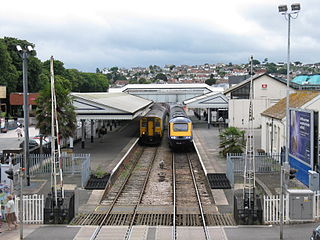
Paignton railway station serves the town and seaside resort of Paignton in Devon, England. It is 222 miles 12 chains (358 km) from London Paddington, via Box. It opened in 1859 and is now the terminus of Riviera Line services from Exeter and heritage services on the Dartmouth Steam Railway from Kingswear.

Torquay railway station is on the Riviera Line and serves the seaside resort of Torquay, Devon, England. It is 219 miles 79 chains (354 km) from London Paddington.

Torre railway station is a stop on the Riviera Line in Torquay, Devon, England. It is 219 miles 12 chains (353 km) down the line from London Paddington, via Box. The station is managed by Great Western Railway but is not staffed. The station buildings are Grade II listed.

Goodrington Sands railway station is on the Dartmouth Steam Railway, a heritage railway in Devon, England. It is close to Goodrington Sands beach and the Splashdown Quaywest water park in Paignton. There has been no scheduled service at the station since 2020.
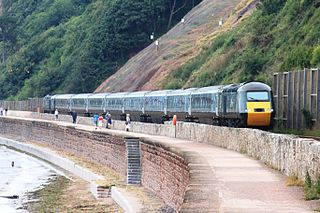
The South Devon Railway sea wall is situated on the south coast of Devon in England. A footpath runs alongside the railway between Dawlish Warren and Dawlish, then another footpath forms a continuation to the sea front promenade at Teignmouth. Both of these form part of the South West Coast Path.
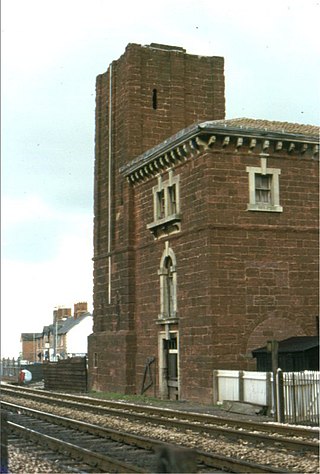
The South Devon Railway engine houses were built in Devon, England, to power the atmospheric trains on the South Devon Railway between Exeter St Davids and Plymouth Millbay railway stations. They contained boilers that provided the power to pumps that created the partial vacuum to move the trains. Three of them still stand largely intact alongside the line.
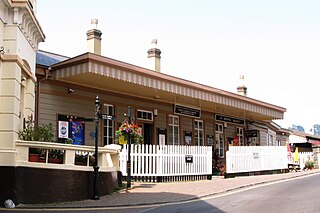
The Dartmouth and Torbay Railway was a broad gauge railway linking the South Devon Railway branch at Torquay with Kingswear in Devon, England. It was operated from the outset by the South Devon Railway.

The A379 is a road in the English county of Devon. It links points on the edges of that county's two principal cities, Exeter and Plymouth, by an indirect and largely coastal route. The A38 provides a faster and more direct inland route between Exeter and Plymouth, whilst the A380 provides a similarly faster route between Exeter and the Torbay area. However the A379 serves many small coastal communities and ports along the coast. The indented nature of the South Devon coast means that the road is usually out of sight of the sea, but the many rivers and estuaries are crossed by bridges and, in one case, a cable ferry.
The South Devon Railway Company built and operated the railway from Exeter to Plymouth and Torquay in Devon, England. It was a 7 ft 1⁄4 in broad gauge railway built by Isambard Kingdom Brunel.
The railway branch line from Newton Abbot to Kingswear in Devon, England, is unusual as a large majority of the stations are still open for traffic. Of the eleven stations, seven are still open so there are only four disused railway stations on this line, a much lower proportion than most similar lines that do not serve big cities.
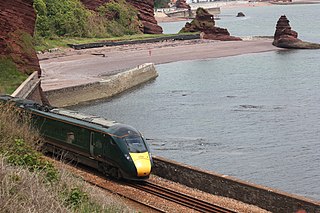
The Exeter–Plymouth line, also called the South Devon Main Line, is a central part of the trunk railway line between London Paddington and Penzance in the southern United Kingdom. It is a major branch of the Great Western Main Line and runs from Exeter St Davids to Plymouth, from where it continues as the Cornish Main Line. It was one of the principal routes of the Great Western Railway which in 1948 became part of the Western Region of British Railways and is presently operated by Network Rail.
The Dawlish Avoiding Line was a proposed 1930s railway development scheme for the Great Western Railway's Exeter to Plymouth Line, which if built would have been an alternative to the existing main line route along the South Devon Railway sea wall.

Marsh Barton railway station is a station in the Marsh Barton area of Exeter, Devon England. It also provides access to the Riverside Valley Park alongside the River Exe. It opened on 4 July 2023 and is on the Riviera Line between Exeter St Thomas and Starcross stations, 2 miles 8 chains (3.4 km) from Exeter St Davids.


























